Alt-F4 #62 - AngelBob vs. Space Exploration vs Industrial Revolution 10-06-2022

This week’s issue #62 is an exciting one, as first-time contributor Laurence makes their debut by tackling a question that a lot of you probably asked yourselves at some point: What’s the difference between some of these big modpacks again? And why might I enjoy one over the other? Laurence played through a few of the big ones, and offers a comprehensive answer to those questions.
Factorio Mod Comparison Laurence
A lot of the appeal of Factorio for me comes from the many different ways it can be approached – you can concentrate on launching rockets as quickly as possible, or you can work on secure defenses to hold back ever-increasing waves of biters. You could build your base around a gigantic maze of belt spaghetti, or maybe you prefer to run clouds upon clouds of bots. You can create a world with massive, dense ore patches to allow you to concentrate on building, or you can set up endless train networks to bring in resources from far across the planet.
And then on the smaller scale, even a simple smelting system can be made in many different ways, perhaps using modules and beacons. The whole game is about solving problems in your own way. This feeling of freedom and variety is only added to by the vibrant mod culture that has been so enthusiastically supported by the developers, from the little quality of life tweaks like Long Reach or Squeak Through, up to the massive modpacks that completely change the feel of the game, such as Space Exploration or AngelBob.
According to Steam, I’ve played almost 2000 hours of Factorio in the last five years. I know that to a lot of people, those are rookie numbers, but it’s been long enough for me to get a good idea of how the game works and to work through a number of modpacks. I started off with completely vanilla runs, restarting a few times when realizing I’d made some kind of hideous abomination, until I finally launched my first rocket. I then messed around with railworlds and various megabase attempts before starting my first big Youtube series back in July 2019 with an AngelBob plus Space Extension run. AngelBob isn’t strictly a mod, rather a collection of mods by two different authors, Arch666Angel and Bobingabout, which work very nicely together. Completing this took me slightly more than a year, but eventually I managed to finish the faster than light research and called that game done.
My next modpack was Space Exploration by Earendel. Earendel is (in)famous for producing such good mods that they were actually hired by Wube, the Factorio developers! I started this run pretty soon after finishing AngelBob and am now about a year and a half in, and I think I’m mostly done, but it will probably take a good few months longer to actually finish it.
Finally, in parallel to Space Exploration, I played through Industrial Revolution 2 with some friends during the second half of 2021. Industrial Revolution 2 was written by Deadlock989, who is known for their excellent artwork - this really shines through in IR2, but more on that later.
So, now I’ve given you a quick rundown of my Factorio experience, I can start on the main topic of this article – comparing the three modpacks, as well as the vanilla late-game experience, talking about what they give you and how they differ in feel. I have also made a video version of this article, which you can watch here.
The feel
Each of the different ways of playing will have its own feel, challenges and stand-out features. In vanilla, the point of a Megabase is to see how far you can expand and how quickly you can launch rockets before your computer starts to struggle, or your train system jams up. The recipes are all relatively straightforward as you’re still using the basic vanilla production, however you’re trying to make it run faster and faster, keeping vast networks of smelters and assembly machines fed and keeping everything running smoothly. The mods all make some significant changes.
AngelBob keeps the same basic goal of launching a rocket, however all of the recipes leading up to it are changed significantly, making it much more complicated. For example, in the early game, ores need to be crushed before they can be smelted. Then later on, you discover that if you sort them or wash them, you can get multiple different metal ores out, and if you then process those through further steps you can at least double the number of plates you produce for each unit of ore, and then even more if you start to use modules.
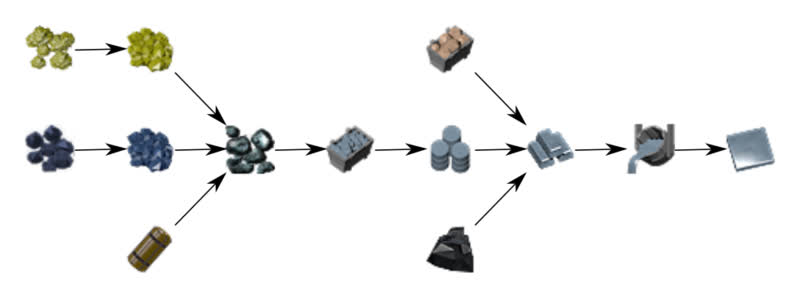
Space Exploration provides a continuation of the base game. When you launch a rocket, you don’t get the “Congratulations, you won!” message; instead, you realise that you’ve just scratched the surface and that there’s far more science to be done. The different types of space science all have different feels and all require different resources - resources which you have to find on other planets. The early game is very similar to vanilla, but it gives you a solar system and deep space to explore once you’ve got rocketry going.
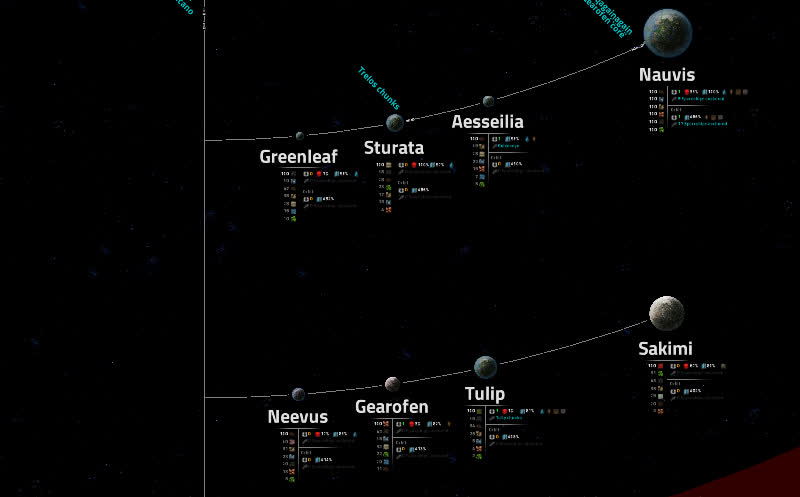
Industrial Revolution also keeps the goal of launching the rocket, but adds in extra early game content with different eras of machines. You begin with steam power, using it to directly power inserters, assembly machines and so on, until you finally research electricity and can start using more conventional machines. It also adds in some extra processing steps for ores and new recipes for circuits, but not to the same extent or complexity as AngelBob.
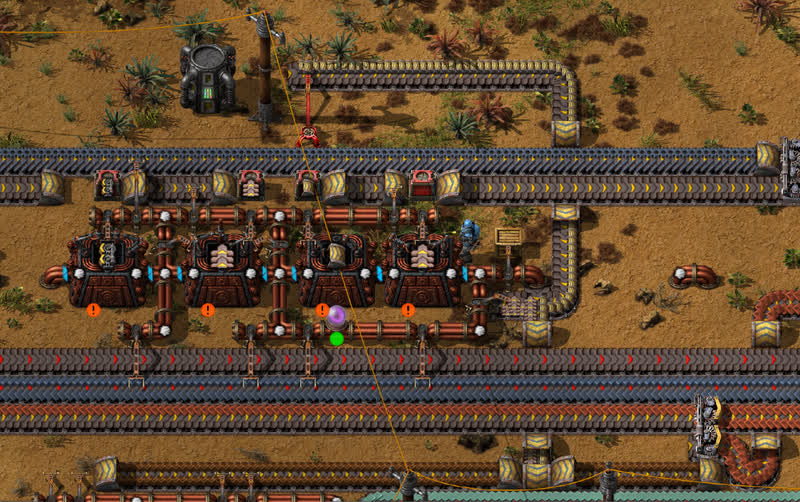
Difficulty Curve
The difficulty with a vanilla megabase lies largely with designing at a scale you haven’t worked at before. This can mean trying to work with longer trains and designing a rail system that can cope with them, or planning out enormous arrays of machines to produce everything you need in sufficient quantities. Once you’ve launched your first rocket, however, there aren’t any new concepts to solve; it’s all about making your existing solutions run faster, more efficiently and on a much larger scale. There’s also nothing in the game to stop you sprawling further and further, so eventually the only limit to your expansion is how powerful your computer is and whether it can keep up with the simulation! This brings up the main challenge in megabase design - making your designs efficient enough that you can squeeze in that extra rocket per minute. It’s definitely a challenge, but not one that I’ve personally been very interested in. I’d rather be solving new puzzles, rather than trying to make my existing solutions more efficient.
AngelBob has a reputation for being one of the hardest modpacks out there, probably second only to Pyanodons (which I haven’t played). A lot of this complexity comes from recipes which involve byproducts. A lot of the mid-game ore refining methods will produce multiple different types of ore, for example saphirite gives you mostly iron, but also some copper. Then if you wash it, you can also get silicon and nickel. Or if you process it again with acid, you get titanium as well. This is much like the Industrial Revolution example I’ll describe below, but taken to a much higher level! Having your titanium production relying on your iron production means that it’s a careful balancing act to produce the right amount of the ores that you want, without producing far too much of the ores that you don’t need. Now sure, you can store the overflow in warehouses – the mod is kind enough to give you massive buildings to store your products – but they will fill up eventually and cause you problems.

Speaking of byproducts, Angel’s Petrochem has a very well-deserved reputation for complexity. Even finding a chain of recipes that will allow you to make plastic from the resources you have is a challenge, but then you realise that you’ve followed the chain through, but you have about ten different tanks filling up with random gasses. And whilst you can vent gasses to atmosphere, because you’re throwing so much of it away, it takes enormous amounts of crude oil or natural gas input to make a very slow trickle of plastic. Oh, but if you put in another massive processing system, then you can take a couple of those byproducts and squeeze a bit more useful stuff out of them, except that makes yet more byproducts! It’s a never ending puzzle, but one which can feel very rewarding whenever you make a bit more progress and increase your plastic production by 10%.

It often feels like Angel’s mods add extra complexity to the game - I’ve described Angel’s Ores and Angel’s Petrochem above - whereas Bob’s mods give you the more powerful tools you need to deal with them. This isn’t entirely true (Bob’s Enemies definitely doesn’t make things easier), but it’s a nice first approximation. This means that you get things like faster belts or trains with larger inventories and higher top speeds. There are also higher tier modules with unique ingredients and more powerful exoskeletons to help you get round your surprisingly large factory. Each tier of a building or mechanism will use the previous tier as a component, plus some more exotic materials. This means that upgrades always use up the materials you’re dismantling, which prevents you from ending up with enormous piles of outdated technology.
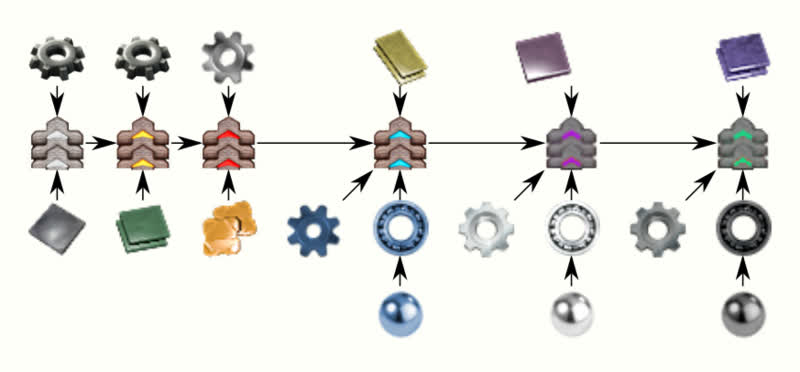
I finished my AngelBob run with Space Extension, which is technically a different modpack, but is fully compatible. This mod requires you to research various types of space technology, however none of them give you any extra toys to play with; they simply act as a massive research sink to test the speed and effectiveness of your factory. Technically, this doesn’t add any extra difficulty, however having research projects which take literally millions of research packs does encourage you to ensure that your factory is running as quickly and efficiently as possible, and gives you an incentive to tweak and improve things, rather than doing just the bare minimum to get to space.
Space Exploration takes the existing difficulty curve of a vanilla game and extends it far beyond the original game. In vanilla you start off with red science, which takes four steps to produce, followed by green science, which is a bit more complicated. Blue science tends to be a bit of a filter where a lot of players will get stuck, and I remember yellow science causing me to struggle in my first few games, mostly because I was struggling to make blue circuits fast enough. Space Exploration continues this with the first space-based science, which is itself fairly straightforward, but made significantly trickier because it has to be made in space, so you’ll need to work out the logistics to get all the components where they need to go, and learn to build in space! It then gives you four paths to follow with different flavours of science: Astronomic, Energy, Material and Biological. These can be tackled in any order and each one will get you different new types of technology. They also all have very different challenges and atmosphere. Material requires making and destroying test packs, then dealing with the scrap, Energy requires lots of very power hungry particle accelerators and Biological involves circulating various different types of ooze. A lot of this sounds like it’s just flavour text and everything will boil down to “put ingredient A and B in machine C to get output D”, and whilst that is true to an extent, the various sciences definitely feel distinct and make you approach them in different ways.
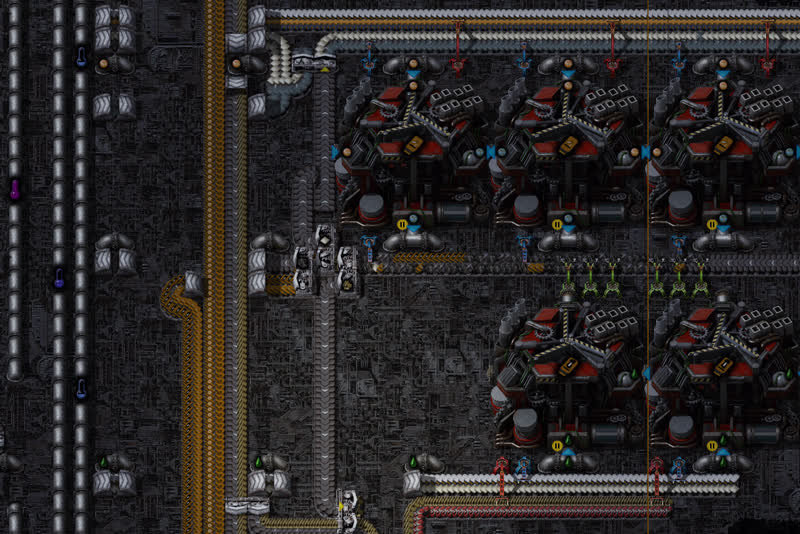
Being spread out across a solar system provides additional logistical challenges in the form of rockets and spaceships. These allow you to move resources between planets at the cost of fuel, but require a lot of infrastructure to keep them loaded and to ensure they go where they are needed. One of the most fun mid to late game challenges is building and programming spaceships - these can be extremely flexible and powerful, but also require a lot of thought to make them do exactly what you want them to.
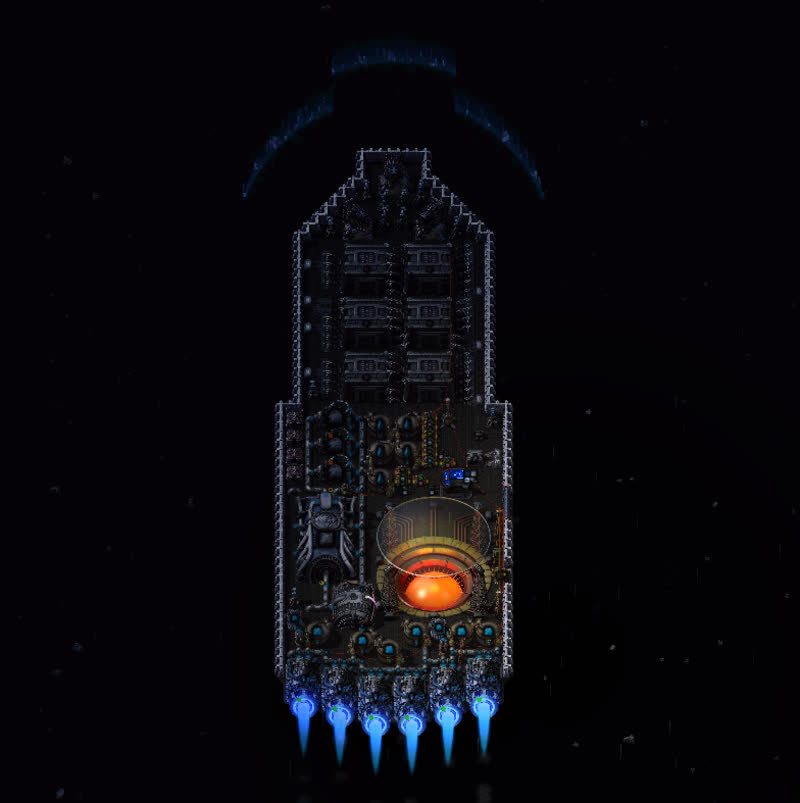
Industrial Revolution introduces new systems to work with from the very start, however in general the designs you’re building aren’t too difficult. Later on, a lot of the difficulty and complexity is provided through a larger number of intermediate steps and intermediate products. This is true in AngelBob as well, however I feel like it blends in more cleanly in AngelBob - it felt like there was a good reason to be making all the intermediate products, whereas Industrial Revolution unfortunately often makes it feel like a bit of a chore. The mod introduces a lot of different states for a metal to be in, ingots, plates, rods, rivets, gears, pistons and so on, and different parts are required for different machines. This is then multiplied by the number of different metals you need to work with as well. Whilst this all felt quite realistic, it makes the logistics much harder if you want to have a central system for producing resources. I ended up shipping ingots around by train as this was the lowest common denominator of all the parts, and then dealing with having to run the ingots through several stages to get the pistons or gears that I actually needed.
Industrial Revolution also includes washing of ores, which allows you to create a second type of metal from each ore. This puts in an interesting byproducts puzzle where you need to balance both the main metal and the byproduct one (e.g. turning gold ore into gold ingots and tellurium) to ensure that you don’t run out of either, but also that you don’t end up with too much of any. I quite enjoyed this step, even if we hadn’t quite got it perfect by the time we finished the run.
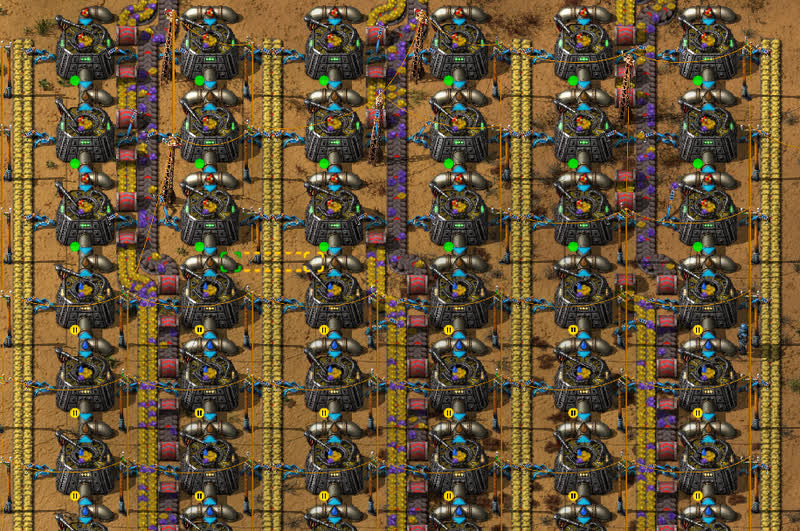
It’s hard to summarise all these changes down to a direct comparison. I think overall, Industrial Revolution is the easiest of the modpacks - it’s certainly the one I finished most quickly, even taking the extra players into account. Space Exploration starts out at vanilla levels of difficulty, but just keeps ramping up and up over time, slowly raising the temperature, but rarely causing you to feel too overwhelmed. AngelBob is much harder almost from the beginning and there were quite a few times when I had to step away to collect my thoughts, however it did keep my interest and I definitely enjoyed the playthrough.
Graphics
All three modpacks introduce lots of new buildings and, as such, need new graphics.
AngelBob is probably the weakest of the three. The new buildings certainly aren’t ugly - it’s generally clear what they do and they’re mostly distinctive, however they don’t fit in quite as well with the general Factorio diesel punk aesthetic as the others do. I also feel that sometimes they look pasted on, like a bad Photoshop - I think this is probably down to detail level, or lighting. Generally, different tiers are distinguished by a palette swap - you go from grey belts to yellow, red, blue, purple and green, which is similar to vanilla. There’s some variety in the quality of the icons for the different materials, with some icons being very high resolution and others being very low. I suspect this comes from the graphics being gradually added over time or from different sources. Most of the time this doesn’t matter, but sometimes you zoom in and the varied resolutions can really stick out. Some of the machines tiers are very difficult to tell apart - one of the crushers (I think) replaces a grey plate on the roof with a dark blue one and unfortunately the two look very similar. That said, I have seen mods with much, much worse artwork than this and I certainly wasn’t bothered by the quality of it while I was playing.

Space Exploration uses a lot of very large machines - especially in space - and these are all excellently rendered. I feel like they fit in very nicely with the general aesthetic, being a higher tech version but still feeling like they’ve come from the same family of machines. They’re all nicely animated too, which makes it easy to tell how busy an area of the factory is. The consistent feel, style and resolution really helps everything come together nicely. That said, there is definitely some artwork reuse in there with a number of machines being recoloured versions of other ones. This doesn’t actually matter though - they’re easy to tell apart and it’s not confusing - however it is a minor downside. I’ve never struggled to tell buildings or resources apart, and only ever struggled to find them due to the sheer quantity of content.
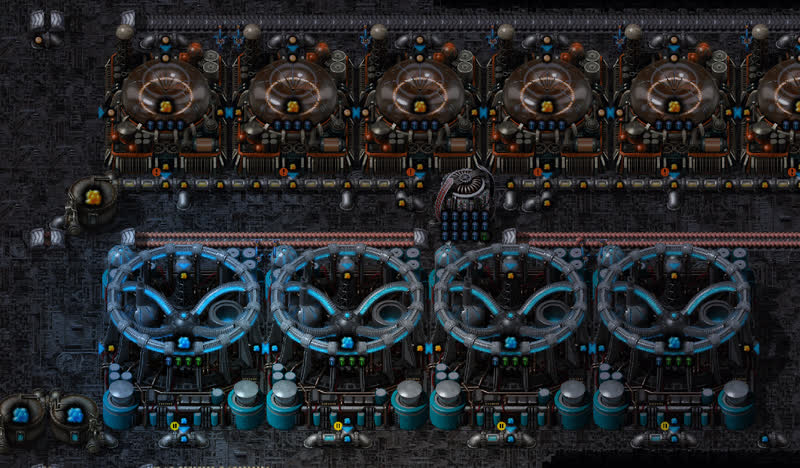
I think that Industrial Revolution is the winner in the graphics area. It doesn’t beat out Space Exploration by much, but the visual interest offered by the three stages of technology - burner, electrical, and laser - really comes across in the artwork. Whilst the different tiers are distinguished by colour, there’s much more to it than that. The assembly machines move from showing big cutting wheels to arc welding to visible laser beams. The furnaces are all completely different shapes. It feels like the machines are all completely distinct, rather than being repainted versions of the tier below. In short, it feels like a lot of care and attention has gone into the artwork in this mod, and the mod looks very good because of it.
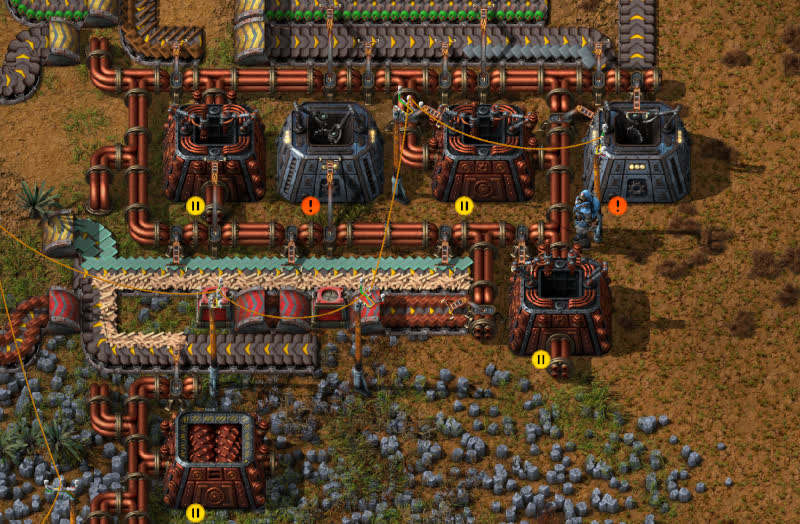
Combat
Combat has never been the main focus of Factorio - past a certain point, the biters are largely there to stop expansion being trivial and to provide an extra load on your factory, which you can treat as a logistics or an efficiency puzzle. In a vanilla megabase, most players will turn biters off to save UPS and even if they’re kept turned on, all you need is a well supplied wall of turrets to keep them out, and a combination of artillery, nukes and personal lasers to push them back.
AngelBob (or more specifically, Bob’s) made the most changes to combat. There are new tiers of biters, with five extra sizes beyond the behemoth, plus enemies with different attack types, such as fire, poison cloud, electric, and so on. That said, whilst the bigger biters had a lot more health, the different attacks didn’t really make a lot of difference - they all just cause damage. In order to help with these stronger enemies, better turrets are available. In the early game, you get the sniper turret which (as you’d expect!) has a slower rate of fire, but high damage and longer range. When you first unlock it, it’s capable of one-shotting a lot of the enemies that come running in. I struggled with combat in the mid-game here as well, at least until I realised I’d researched the plasma cannon. This weapon can devastate a biter attack with huge damage levels and splash damage, however you have to be very careful to avoid friendly fire - it can knock a hole through your entire defensive line and kill even a heavily armoured player. It also draws a lot of power!
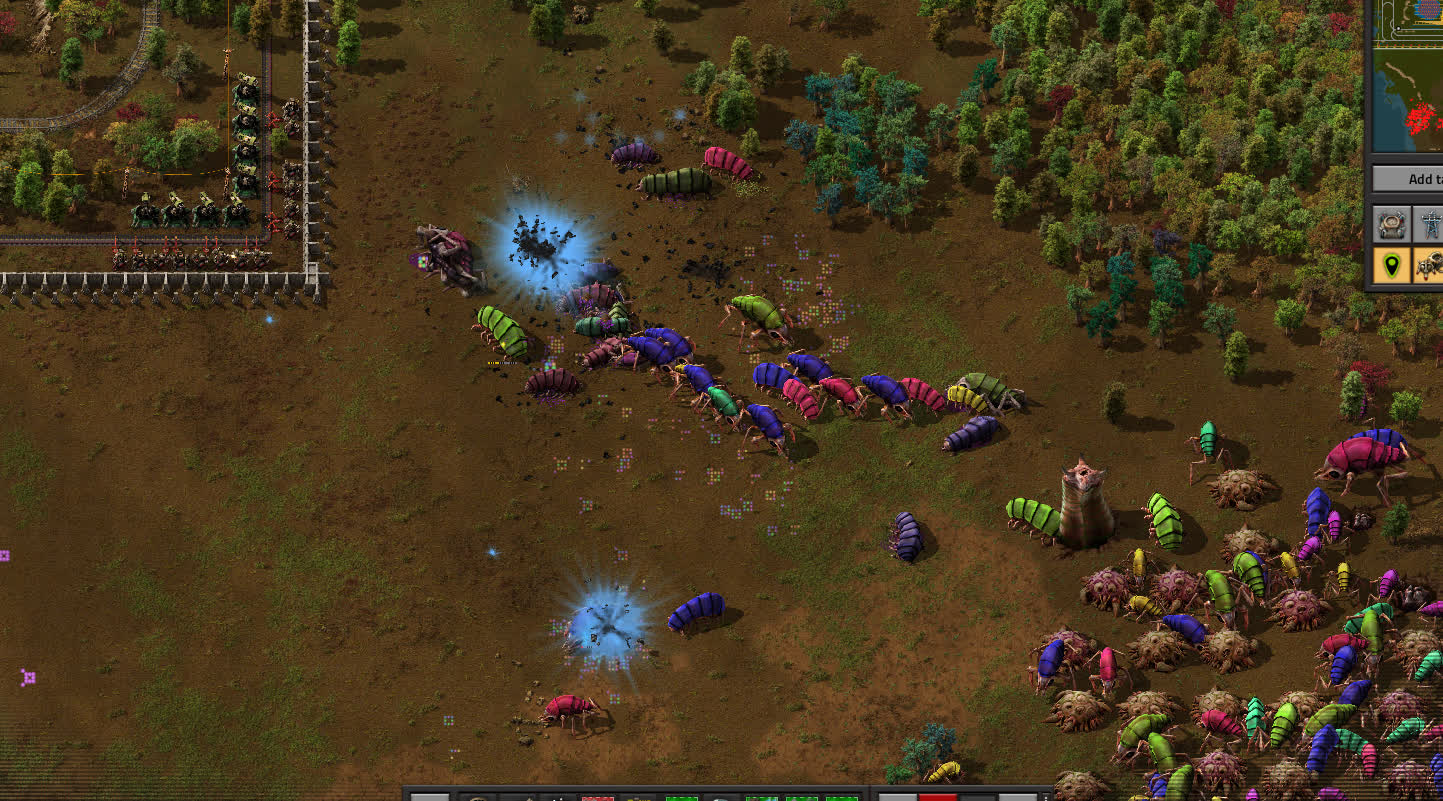
Space Exploration doesn’t do a huge amount with combat. There are no new types of biters or spitters to worry about and the standard wall with bullet and flame turrets has done well for me. You do get some interesting new personal weapons gated behind the space sciences which help to make the player a bit more dangerous. These include the lightning gun, which chains attacks together allowing you to attack an army all at once, a biogun which I think is supposed to do more damage the more biters there are around and a railgun which is a powerful, long range, single shot weapon. You also get some industrial scale weapons including an interplanetary railgun, a plague rocket which can wipe out all life on a planet and a solar-powered energy beam that can burn a trail of destruction over the landscape. Despite all these new toys, I haven’t done much with them. The vanilla style wall is keeping my base on my home planet of Nauvis safe and you can generally find peaceful planets to gather your resources. I think there’s potential in the more advanced weapons, but the game hasn’t pushed me into having to use them much. You do need to worry about defending against meteor strikes and the occasional coronal mass ejection, and much like the biters, this gets easier as you advance through the game.
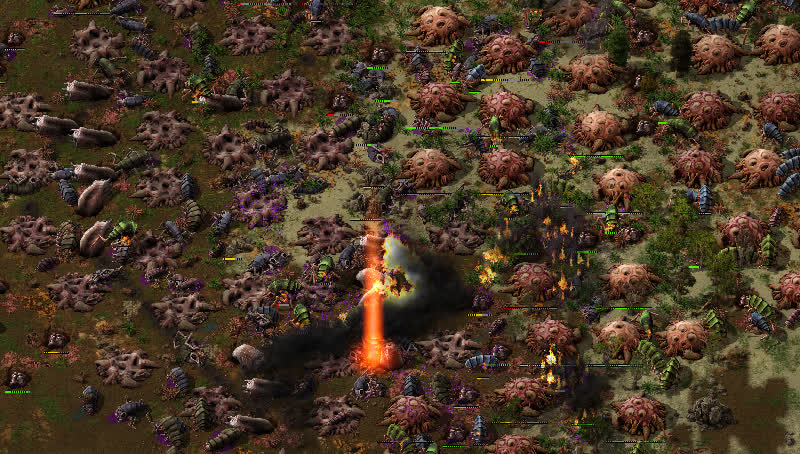
Industrial Revolution also keeps the vanilla enemies, but it replaces the turrets with a scattergun turret and a modified machinegun turret. There are also new types of ammunition, both shotgun and bullet, for the player to work through. I found that the bullets didn’t feel as powerful as in vanilla, which made combat harder, however the shotgun and scattergun turret really packed a punch at short range. This was interesting as it encourages the player to build out their defenses with a mix of different weapons in order to provide a thorough and complete defense. We definitely struggled with combat in the mid-game and I’m not sure whether this was due to releasing more pollution due to having multiple players, or due to the mod making it harder. Either way, it’s a good thing we had multiple players, as it allowed us to support each other and to have one player working on defense while another made sure the ammo supply could keep up!
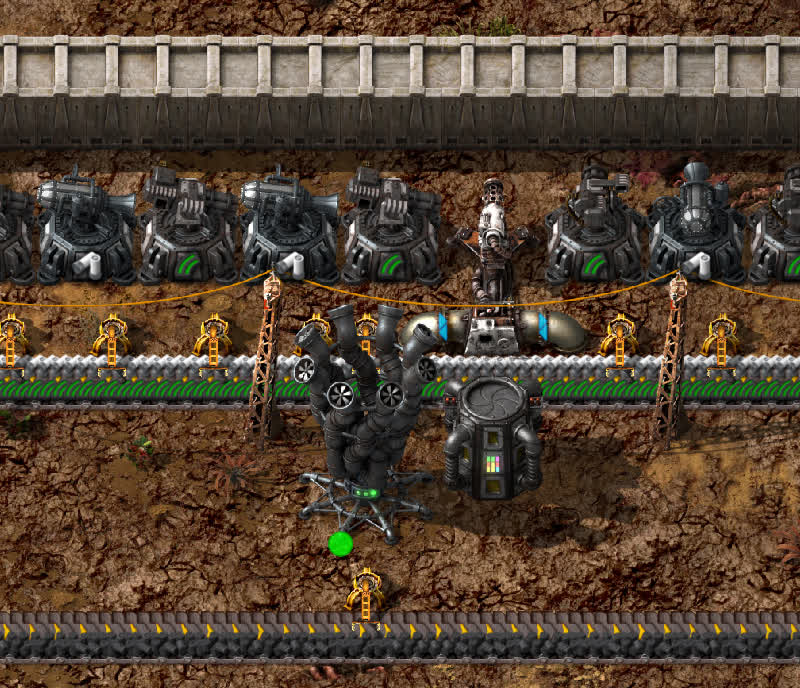
Final Thoughts
The three mods do all feel different due to their approaches. I feel like Space Exploration works very well as an expansion, as it has an excellent, smooth difficulty curve. AngelBob is a good choice if you want more complicated processes and something that ramps up the difficulty from the start, rather than being gentle early on. Industrial Revolution is definitely more difficult to progress through than vanilla, but it feels like it’s more about repeating the same steps more times. Finally, a vanilla megabase is a challenge in throughput and logistics.
Exploring a new modpack can be a great adventure. Space Exploration pulls this off on the grandest scale with new planets to explore (all with their own terrain types, thanks to the Alien Biomes mod) and new resources to find, plus the additional challenges of building in space. I’d put AngelBob in second place here as there’s always interest in a longer or faster inserter, ludicrously fast exoskeletons or nuclear construction bots. There’s also new ways to process the ores you’ve been working with so far and the daunting task of making a new type of circuit. It’s a different type of exploration, but it’s still great fun. Industrial Revolution also includes new ways to process resources and new toys to play with, but it didn’t have quite the same excitement for me, personally.
Replayability is an extremely important part of Factorio, with a lot of people putting in literally thousands of hours into the game. Playing vanilla allows you to come up with more efficient systems for producing the science packs, whether that’s untangling your rail network, designing layouts with more beacons or building a faster smelting array, and these urges to improve are what keep us coming back. When I finished AngelBob, I had a number of ideas for things I would do differently, and was tempted to play again to try them out, but decided fairly quickly that I’d rather move on to a different mod. With Industrial Revolution, once I finished it, whilst I’m sure I could have made a more efficient factory if I’d played again, I didn’t have any urge to. I’d enjoyed the game, but didn’t want to play through it again. Space Exploration has a lot more flexibility, so there are already things I know I want to try on my next run (perhaps largely skipping the rockets stage of the game, or doing my ore processing in one massive central system). I already have plans to do a run combining Space Exploration with Krastorio 2 with my friends once we’ve finished our current Minecraft run.
If you want to find out how my future runs go, or see how I’m getting on with Space Exploration, feel free to have a look at my Youtube and Twitch channels. I have an engineering background and have since moved on to tech writing, so I’d like to think I approach these games in a logical and interesting way! Oh yes, and I have an overactive sense of humour, and a bad habit of breaking out in showtunes. I currently stream Space Exploration on Wednesday evenings (UK time) and release summary videos of the streams every Sunday. The channel also has our Minecraft: Dungeons, Dragons and Space Shuttles playthrough (streams Monday, videos Saturday) and GTA Manhunt runs (Thurs). I also plan to take a look at Dyson Sphere Program at some point in the future.
Thank you for reading and I hope you’ve enjoyed my impressions of these mods. If you have any questions, come along to one of the streams and ask me about it there!
Contributing
As always, we’re looking for people that want to contribute to Alt-F4, be it by submitting an article or by helping with translation. If you have something interesting in mind that you want to share with the community in a polished way, this is the place to do it. If you’re not too sure about it we’ll gladly help by discussing content ideas and structure questions. If that sounds like something that’s up your alley, join the Discord to get started!